What Challenges Await CEOs and Executives in 2025? Global CEO Report based on IESF Study.
Global markets are becoming increasingly unpredictable, and CEOs face a range of challenges.
As part of the first edition of the IESF Global CEO Outlook Study 2025, we conducted 640 interviews with company presidents from 18 countries to understand the key issues they will face in the coming year.
The results are clear: digitalization, cost pressures, recruitment challenges, expansion into new markets, and geopolitical risks will play a crucial role in shaping business strategies.
We present the key findings from the Global CEO 2025 report and insights for business leaders that can help them navigate the evolving global economic landscape effectively.
Global CEO Priorities by Region: EMEA, Americas, and APAC

Percentage Breakdown of CEO Priorities by Region
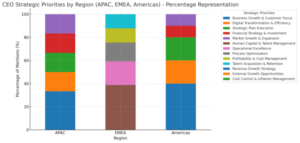
1. Cost Optimization and Profitability – The Key to Stability
Economic uncertainty, inflation, and rising operational costs are driving business leaders to analyze their finances carefully and find new ways to improve efficiency.
🔹 Reducing operational costs – Companies are reviewing their cost structures, seeking savings through process automation, renegotiation of supplier contracts, and supply chain optimization.
🔹 Better cash flow management – Working capital management and financial flexibility are essential for stability in uncertain times.
🔹 Technology-driven savings – AI and data analytics help identify areas where costs can be optimized without negatively impacting service quality.
CEO Takeaway: To stay competitive in 2025, finding the right balance between cost-cutting and investment in the future—innovation, talent, and expansion—is essential.
2. Digital Transformation and AI – Accelerating Smart Business
2025 will mark the full adoption of artificial intelligence, automation, and digitalization. Companies that fail to invest in modern technology risk losing their competitive edge.
🔹 Process automation – AI replaces repetitive tasks, freeing up human resources for more strategic activities.
🔹 Cybersecurity – As digitalization increases, so does the risk of cyberattacks, making investments in advanced data protection systems essential.
🔹 Personalizing customer experiences – AI enables companies to understand consumer needs better and deliver personalized products and services.
CEO Takeaway: Digital transformation is not just about cost reduction—it is a powerful tool for gaining a competitive advantage. Investing in AI and data analytics can significantly enhance operational efficiency and innovation.
3. The War for Talent – The Biggest Challenge in the Labor Market
A shortage of skilled workers in key sectors such as IT, engineering, and finance is forcing companies to adopt new recruitment strategies.
🔹 Employer branding and organizational culture – A strong employer brand is crucial in attracting top talent. Companies are investing in benefits, development programs, and work-life balance initiatives.
🔹 Flexible work models – Hybrid work remains the norm, and companies must adapt their structures and tools to this new reality.
🔹 Developing internal talent – As external recruitment becomes increasingly difficult, companies are investing in training and reskilling programs for existing employees.
CEO Takeaway: Retaining and developing talent requires an innovative approach to workforce management. Companies that create an attractive work environment will gain a competitive advantage.
4. Expansion into New Markets – The Key to Long-Term Growth
Despite challenging macroeconomic conditions, many CEOs plan international expansion to diversify revenue sources.
🔹 Mergers & Acquisitions (M&A) and strategic partnerships – More companies are choosing acquisitions and collaborations with local businesses to enter new markets more quickly.
🔹 Expansion into Asia and Latin America – These regions offer significant growth potential, attracting investment from companies in Europe and North America.
🔹 New business models – Subscriptions, e-commerce, and digital services enable rapid international business scaling.
CEO Takeaway: Global expansion requires thorough risk analysis and a flexible approach. Companies that quickly adapt to local conditions will gain a competitive edge.
5. Geopolitical and Economic Uncertainty – How to Manage Risk?
Political volatility, trade wars, and increasing international tensions are forcing companies to adjust their risk management strategies.
🔹 Supply chain review – Many companies are diversifying suppliers and avoiding dependence on a single region.
🔹 Regulatory adaptation – Global businesses must monitor legislative changes affecting international trade and taxation.
🔹 Scenario planning – Companies increasingly use predictive models to prepare for various market scenarios.
CEO Takeaway: Operational stability and security will be critical in the coming year. Proactive risk management strategies are necessary to minimize potential losses.
Conclusion: What Should the CEO Strategy Be for 2025?
The coming year will bring both challenges and immense opportunities for companies ready to embrace adaptation and innovation. To manage their organizations effectively, CEOs should focus on:
✅ Integrating new technologies – AI, automation, and data analytics will become essential business strategy components.
✅ Investing in people – A strong employer brand and talent development will be key to success.
✅ Managing risk – Geopolitical instability requires flexible and well-thought-out actions.
✅ Long-term vision – Companies that think ahead and invest in innovation will emerge as industry leaders.
One Key Takeaway
2025 will present both challenges and immense opportunities for companies that take a strategic approach. The key to success will be adapting quickly to market changes, investing in new technologies, and effectively managing talent and risk.
👉 If you want your company not only to survive but also to thrive, working with experienced experts is essential. Our agency supports business leaders by helping them save costs through the selection of top managers, onboarding control, and leadership soft skills development.
Top CEO Challenges in 2025 by Industry
Energy & Sustainability
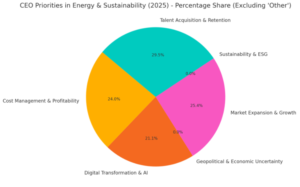
Finance & Banking
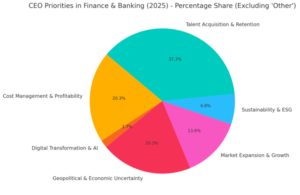
Healthcare &Life Science
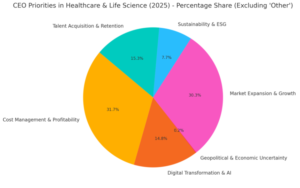
Manufacturing & Industrial Services
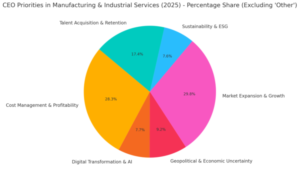
Technology & Engineering
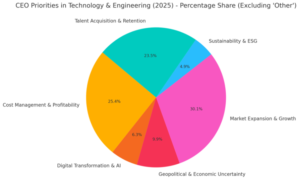
Source of data www.iesf.com
Here you will find an in-depth analysis of the responses from CEOs in Poland. Key Challenges for CEOs in Poland in 2025.
📩 Contact us today to find out how we can help your company reduce costs and improve ROI by placing the right manager in 2025! You might find this interesting.

